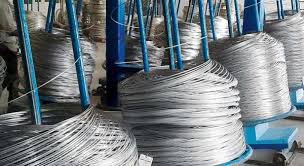
Stainless wire, a critical component in various industries, is renowned for its unique properties and versatility. This type of wire, made from stainless wire rope steel, combines strength, durability, and resistance to corrosion, making it indispensable in applications ranging from construction to medical devices. In this article, we will explore the characteristics, types, manufacturing processes, and diverse uses of stainless wire.
Characteristics of Stainless Wire
Stainless wire is distinguished by several key properties:
- Corrosion Resistance: One of the most significant advantages of stainless wire is its resistance to rust and corrosion. This is due to the presence of chromium in the alloy, which forms a passive layer of chromium oxide on the surface, protecting the material from oxidative damage.
- Strength and Durability: Stainless steel wire exhibits high tensile strength, making it suitable for demanding applications where robustness is essential. It also maintains its integrity under extreme temperatures and environmental conditions.
- Aesthetic Appeal: Stainless wire has a sleek, modern appearance that is often utilized in architectural and design applications for its clean and attractive look.
- Hygienic Properties: The non-porous surface of stainless steel prevents the accumulation of bacteria and other pathogens, making stainless wire ideal for medical and food processing applications.
Types of Stainless Wire
Stainless wire is available in various grades and forms, each tailored for specific applications:
- Austenitic Stainless Steel Wire: This type, which includes grades like 304 and 316, is known for its excellent corrosion resistance and formability. It is widely used in food processing, chemical industries, and marine environments.
- Ferritic Stainless Steel Wire: Grades such as 430 fall into this category. Ferritic stainless steel wire is magnetic and has good resistance to stress corrosion cracking. It is commonly used in automotive and industrial applications.
- Martensitic Stainless Steel Wire: With grades like 410 and 420, this type offers high strength and hardness. It is often used in applications requiring wear resistance, such as cutlery and surgical instruments.
- Duplex Stainless Steel Wire: Combining austenitic and ferritic structures, duplex stainless wire, like grade 2205, provides superior strength and corrosion resistance, making it suitable for demanding environments like oil and gas exploration.
Manufacturing Processes
The production of stainless wire involves several stages:
- Melting and Casting: Stainless steel is produced by melting raw materials, including iron ore, chromium, nickel, and other elements, in an electric arc furnace. The molten steel is then cast into billets or slabs.
- Hot Rolling: The cast billets or slabs are heated and passed through rolling mills to form wire rods. This process reduces the cross-sectional area and shapes the wire.
- Cold Drawing: The wire rods are further processed through cold drawing, where they are pulled through a series of dies to achieve the desired diameter and surface finish. Cold drawing enhances the mechanical properties of the wire.
- Annealing: To relieve internal stresses and improve ductility, the wire undergoes annealing, a heat treatment process. This step is crucial for ensuring the wire’s performance in various applications.
- Surface Finishing: The final stage involves surface treatment, such as pickling or passivation, to remove any scale or impurities and enhance the wire’s corrosion resistance.
Applications of Stainless Wire
Stainless wire is used in an array of industries due to its exceptional properties:
- Construction: In the construction industry, stainless wire is employed in reinforcing bars, suspension cables, and structural components. Its strength and corrosion resistance make it ideal for these demanding applications.
- Medical Devices: Stainless wire is essential in the medical field for surgical instruments, orthopedic implants, and dental braces. Its biocompatibility and hygienic properties are crucial in these applications.
- Automotive: In the automotive sector, stainless wire is used for exhaust systems, airbags, and springs. Its ability to withstand high temperatures and harsh environments ensures the reliability of these components.
- Aerospace: The aerospace industry relies on stainless wire for safety wires, control cables, and fasteners. Its strength-to-weight ratio and resistance to extreme conditions are vital for aerospace applications.
- Food Processing: Stainless wire is extensively used in the food processing industry for conveyor belts, wire mesh, and cooking utensils. Its non-reactive surface prevents contamination and ensures food safety.
- Marine: In marine environments, stainless wire is used for rigging, mooring lines, and fishing nets. Its corrosion resistance makes it suitable for prolonged exposure to saltwater.
Conclusion
Stainless wire, with its unparalleled combination of strength, durability, and resistance to corrosion, is a versatile material that plays a crucial role in numerous industries. From construction and medical devices to automotive and aerospace applications, the unique properties of stainless wire ensure its indispensability in modern technology and infrastructure. As advancements in materials science continue, stainless wire will undoubtedly remain at the forefront of innovation and application.